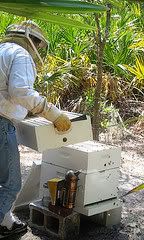Monday, March 20, 2006
About Me
- Name: FLbeekeeper
- Location: Florida, United States
An individualistic thinker, one who will point out faults, give opinions, and generally, support the "against the man" approach to politics.
Previous Posts
- The Russians are finally getting their act together!
- Where did they go?
- ...what falls through the cracks.
- Remember that TBH (Top Bar Hive)?
- Trapped Above
- Pollen-Bound
- Hmmmmm...a little light.
- Same as Last TIme
- Why are their two races of bees in my hive?
- Unconfortably Close

2 Comments:
Everyone has been enjoying the honey you so graciously endowed us with. Thanks again.
I wonder how the russian variety will come out?
Red perhaps...
The color of honey has to do with it's floral source, water content, relative humidiy of the air, air temperature, soil quality, soil temperature, soil moisture and pollution of air, soil or water surrounding. The race of honeybees usually indirectly affects the honey as to weither it will have "wet" cappings or "dry" cappings and if propolis will be incorporated into the wax. None of those affect the honey in any way just the look of it in the comb. Wet cappings refer to the wax capping touching the honey inside...therefore making it look wet. Dry cappings have a space of air between the honey and the capping; thus making the capping look dry. The race of honeybee will, however, affect temperment, population size, honey production, propolis gathering, wax secreation, capping type, winter cluster, colloration of the bee itself and speed of "spring build-up".
Woohoo...I'me well on my way to making a book...lol
Post a Comment
<< Home